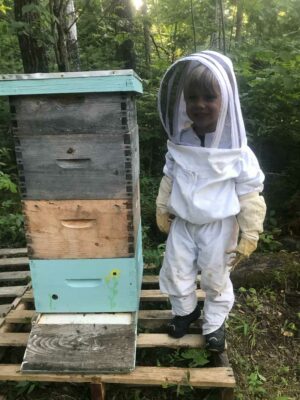
The buzz started when Tim Marshall spent a week at the Sheldon Valley Outdoor Education Centre as a Rolph Road Public School Grade 6 student.
Sheldon Valley had honeybees, and Tim fell in love with these beautiful insects. So much so that he got a colony of bees and was allowed by his parents to set them up on their hobby farm near Collingwood. It wasn’t possible to use a Leaside backyard, because a hive is required to be 30 feet from the property line. With some help from teacher Martin Hunt and his parents, Tim continued his beekeeping through high school. There was a hiatus while he attended Wilfrid Laurier University and Canadian Memorial Chiropractic College.
After telling his wife, Judy, about his earlier beekeeping adventures, she bought him a colony for his birthday, and it’s now become a family activity. Their three children, Norah, Calvin and Milo, all help with hive activities when they go to their property on weekends. Luckily, bees are generally quite self-sufficient, so the main work is in the spring to ensure they have enough food (sugar and water) when they are starting to move about before spring blossoms appear, and then, of course, there’s harvesting the honey later in the year.

As you can imagine, it is necessary to be well suited up to avoid being stung when close to the hive. Especially in the city, most people who say they’ve been stung by a bee have actually been stung by a wasp or hornet. There aren’t that many bee colonies in urban settings, plus a bee needs to feel threatened to sting, because after stinging, it dies. Wasps and hornets do not.
Tim and his family now have four bee boxes, each with three layers, called supers. In each super, there are 10 hanging frame racks which the bees use to make their wax honeycomb and then fill the combs with honey. When it’s harvesting time, the hives are smoked to make the bees “peaceful” and less likely to sting, while the racks are removed. The racks are whirled in a centrifuge to extract the honey. Most of the comb remains for the bees to rebuild when the rack is returned to the hive. The honey is strained to remove the bits of broken comb. There is no need for pasteurization because honey is antimicrobial and never gets moldy. The usual yield in a year is about 100 litres. Last year, Norah, Calvin and Milo sold honey at their schools (respectively Leaside High, Bessborough and Rolph) when the schools were doing fundraising to help Ukraine. Several years ago, the children exhibited at the Royal Winter Fair and got coverage on Breakfast Television and in the Globe & Mail! They’ve also been known to set up a stand on Bayview.

Tim always knew that beekeeping “wasn’t a normal kid thing to do,” but he really enjoyed what he was doing. Now, he describes it as “being peaceful working with bees – almost meditative.” Over these last years, we’ve all become more aware of the importance of the role bees play as pollinators. We are also learning more about the dangers to hives by colony collapse disorder.
If you’ve read this far, you will realize that Tim is a second-generation Leasider. He grew up on Sutherland Drive beside Rolph Road School, and he and his wife made a conscious decision to find a home in Leaside, which by coincidence is also on Sutherland. His children attend the schools he attended. And while his wife, Judy, was not originally a Leasider, she now works in Leaside – farther up Sutherland as a doctor at Lyndhurst.
And yes, Tim is actually Dr. Tim Marshall, of the Bayview Chiropractic Health Centre at 1555 Bayview Ave. Chiropractor – and beekeeper!


